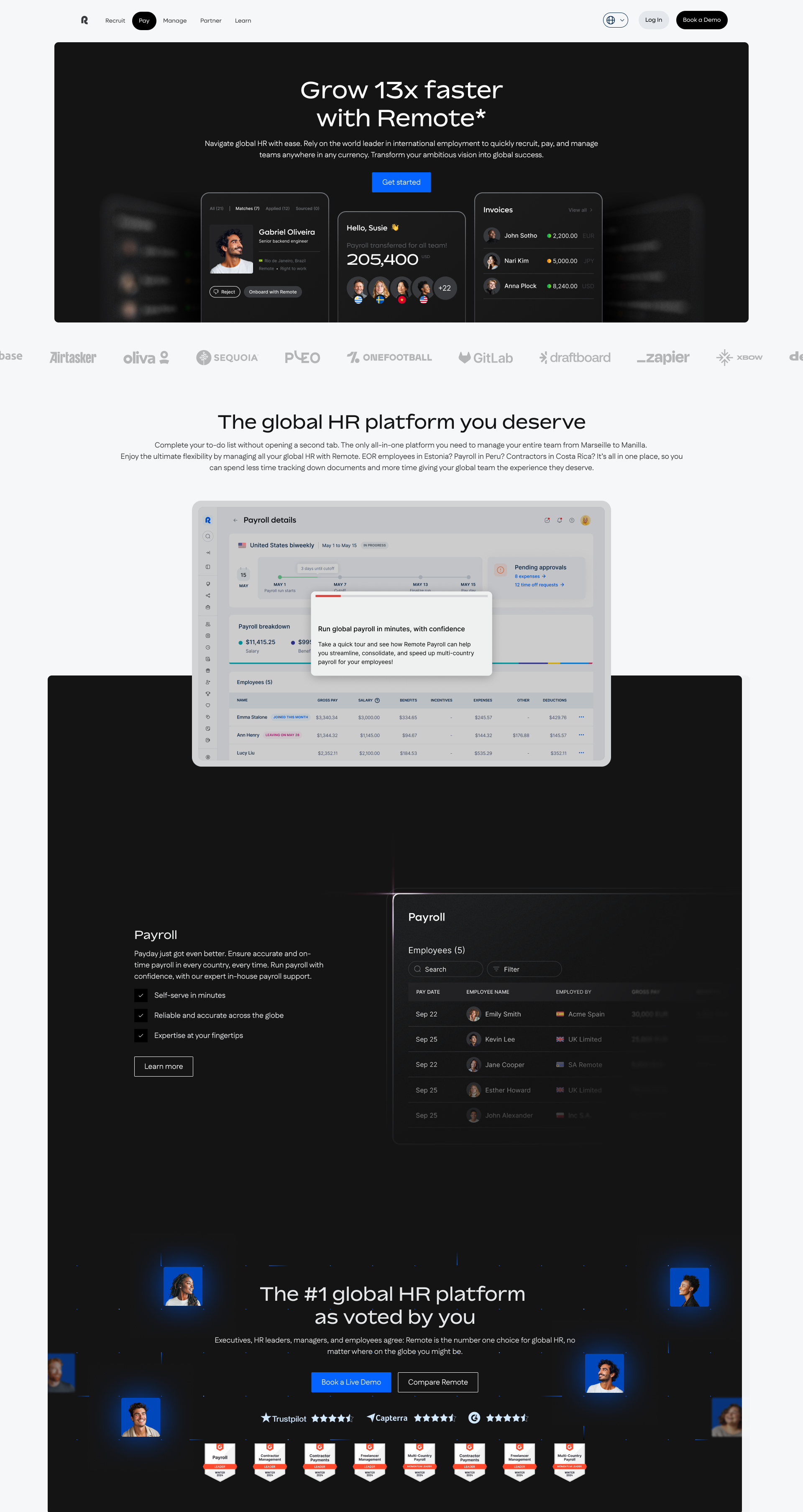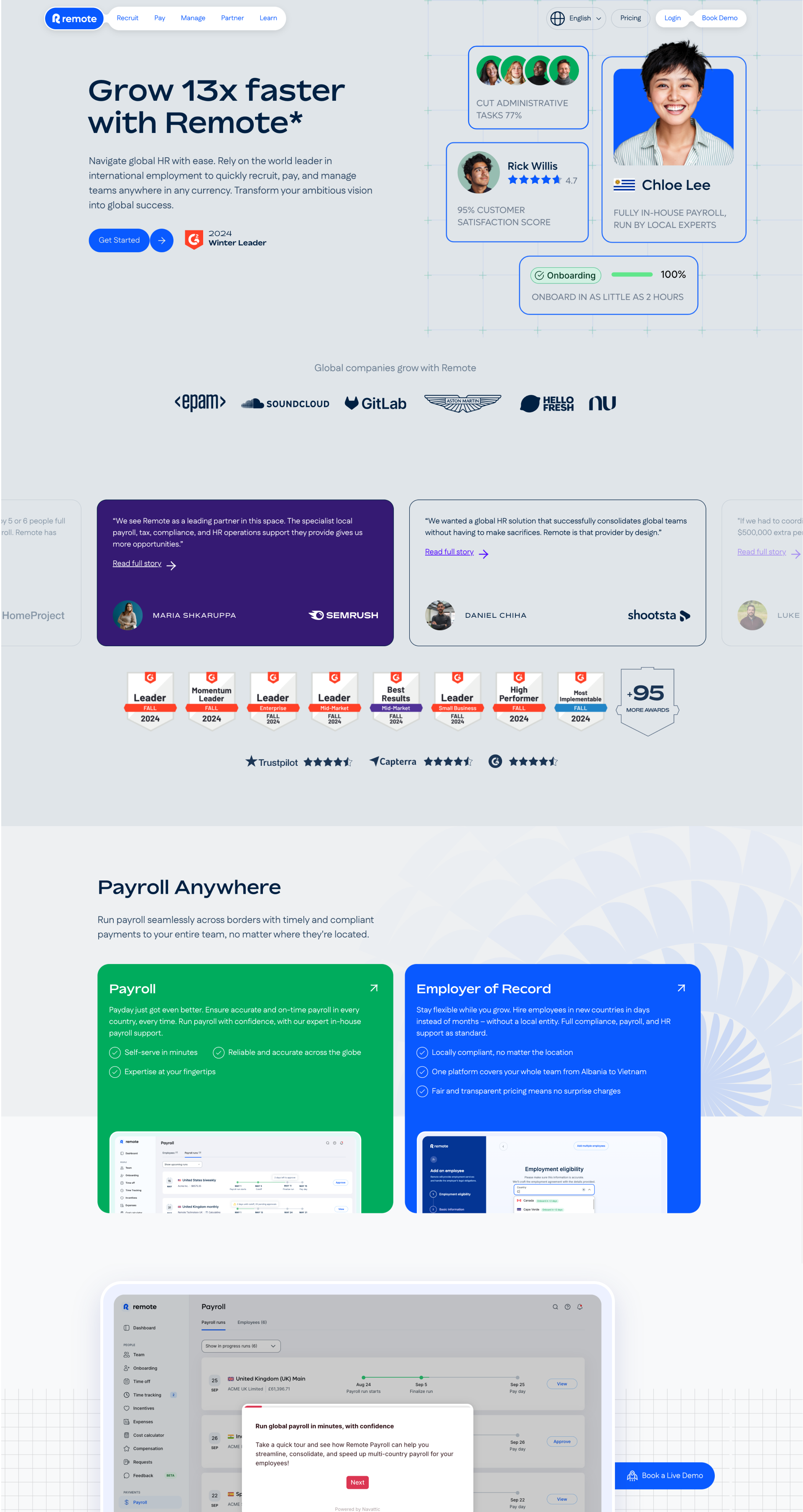Enterprise-Scale CMS Transformation & Design System Rollout
Project Overview
Lead Remote's global rebranding and large-scale CMS migration of 30,000+ pages across 7 languages in just 3 months. The transformation was key to unifying product and brand identity, improving scalability, and accelerating global growth. My focus was on orchestrating systems, automation, and cross-functional collaboration rather than individual screen design, with further scaling and testing rolled out over the following 6 months to optimize conversion and expand system adoption.
Role
Staff Brand & Product Designer
Company
Remote
Year
2024-2025
Timeline
3-6 months
Team
20+ stakeholders (marketing, SEO, localization, engineering, product)
Achievements
30,000+ CMS pages audited & migrated
//
7 global markets localized & unified
//
3 months delivery deadline met
//
3,500+ design tokens powering product & brand
//
8 adaptive color modes across UI/marketing
//
200+ reusable components in system library
//
3x faster release cycles for product & marketing launches
//
5+ cross-functional orgs aligned under one roadmap
//
10–15% projected uplift in conversion on high-traffic flows
//
6 months post-launch optimization & scaling
//
30,000+ CMS pages audited & migrated
//
7 global markets localized & unified
//
3 months delivery deadline met
//
3,500+ design tokens powering product & brand
//
8 adaptive color modes across UI/marketing
//
200+ reusable components in system library
//
3x faster release cycles for product & marketing launches
//
5+ cross-functional orgs aligned under one roadmap
//
10–15% projected uplift in conversion on high-traffic flows
//
6 months post-launch optimization & scaling
//
Core Challenges & Actions
| Challenge | Action |
|---|---|
|
1. Unifying Product & Brand Identity Fragmented design language across product and marketing, leading to inconsistent user experience and slower delivery. |
Built a unified design system with 3,500+ tokens, 8 color modes, 200+ UI components, supported by Figma libraries and Storybook documentation. |
|
2. Migrating 30k+ Pages in 3 Months Aggressive 3-month deadline to migrate 30,000+ multilingual pages (7 languages) from a fragmented legacy CMS. |
Audited layouts and content flows, streamlined templates with SEO & localization teams, and introduced automation pipelines to accelerate migration. |
|
3. Scaling Delivery Across Distributed Teams Cross-continental collaboration (EMEA & AMER) risked bottlenecks and delays. |
Established async rituals, automated design-to-code token syncs, and integrated AI-driven telemetry & CRO testing for continuous iteration. |
|
4. Aligning Cross-Functional Stakeholders 5+ teams (marketing, SEO, engineering, localization, product) had competing priorities and workflows. |
Introduced governance standards, async decision-making frameworks, and weekly cross-functional syncs to align under a single roadmap. |
Process Seams — Where I Fixed the Flow
Audit & Inventory
Prioritization
Tokenized System
Templates
Migration
QA & Localization
CRO & Telemetry
Launch & Scale
Audit & Inventory
Duration: 2 weeks
Seam Fix: Exposed fragmentation in 30k+ URLs and layouts; introduced a scoring model (traffic, intent, SEO authority) to focus migration.
Artifacts & Owners: Prioritization rubric, redirect map · PM/SEO
Outcome: Work shifted toward high-impact pages, reducing wasted effort.
Prioritization & Governance
Duration: 2 weeks
Seam Fix: Eliminated siloed decision-making by codifying rules for sunsetting, merges, and redirects; defined ownership for change requests.
Artifacts & Owners: Governance matrix, redirect rules · PM/SEO/Design
Outcome: Clear scope, fewer disputes, smoother cross-team alignment.
Tokenized Design System
Duration: 3 weeks
Seam Fix: Broke the cycle of inconsistent styling by introducing a token taxonomy, accessibility baselines, and component contracts.
Artifacts & Owners: Token spec, a11y checklist · Design/Eng
Outcome: Unified product + brand system; predictable handoffs.
Template Factory (Figma + Storybook)
Duration: 3 weeks
Seam Fix: Prevented design-engineering drift by standardizing archetypes and slot mapping, with Storybook "done" criteria baked in.
Artifacts & Owners: Figma libraries, Storybook docs · Design/Eng
Outcome: Teams could work in parallel with fewer regressions.
Content Migration Pipelines
Duration: 3 weeks
Seam Fix: Removed manual bottlenecks by mapping CMS fields and creating ingestion scripts with guardrails for assets/links.
Artifacts & Owners: Mapping sheet, automation scripts · Eng/Marketing Ops
Outcome: Faster migration with reduced QA overhead.
QA & Localization Loop
Duration: 2 weeks
Seam Fix: Closed gaps in quality by adding glossary standards, automated checks, and async visual diffs across locales.
Artifacts & Owners: Localization playbook, QA checklist · Loc/QA
Outcome: Reduced errors, faster approvals across 7 languages.
CRO & Telemetry
Duration: Continuous (post-launch)
Seam Fix: Replaced guesswork with Hotjar insights, telemetry dashboards, and KPI hooks embedded in templates.
Artifacts & Owners: Experiment matrix, CRO dashboards · Growth/Design
Outcome: Modeled 10–15% uplift; experiments fed back into the system.
Launch & 6-Month Scale
Duration: 6 months post-delivery
Seam Fix: Ensured safe scaling by implementing staged rollouts, rollback rules, and a telemetry-fed backlog.
Artifacts & Owners: Rollout plan, adoption docs · PM/Eng/Design
Outcome: Smooth global launch and continuous optimization loop.
A token-driven foundation that streamlines theming and scaling, helping teams ship faster without adding complexity.
Research & Insights
To guide design decisions and validate migration outcomes, I introduced a mix of quantitative analytics and qualitative feedback loops:
Hotjar heatmaps & session recordings
Track user behavior across high-traffic landing pages, identify drop-offs, and test CRO hypotheses.
Internal telemetry dashboards
Monitoring interaction patterns, template usage, and localization performance at scale.
Content owner reviews
Ran structured feedback sessions with SEO, localization, and marketing stakeholders to evaluate new CMS flows.
Design QA & internal reviews
Weekly async audits across design, engineering, and marketing to ensure consistency before go-live.
A/B testing & CRO experiments
Iterated on landing page templates to model a projected 10–15% uplift in conversions.
A single, modular card component that scales into complex CMS sections — giving teams flexibility in design, faster page creation, and future-proof scalability.
Centralized Figma navigation acting as a single source of truth — giving cross-functional teams easy access to the right information when they need it.
Complex section variables built to handle content and language flexibility — ensuring scalable, adaptable layouts across markets.
Before & After Transformation
Drag the slider to explore the evolution of Remote's design system and migration process:
Reflection / Lessons Learned
Leading at Scale
Spending more time on strategy — alignment, governance, and workflows — made UI execution faster and more consistent across 30k+ pages.
Systems over Screens
Design tokens, documentation, and component libraries proved more valuable than polishing individual screens, enabling 3x faster delivery.
Bridging Brand & Product
By treating brand and product as one system, we created a shared language that scaled seamlessly across marketing and product experiences.

